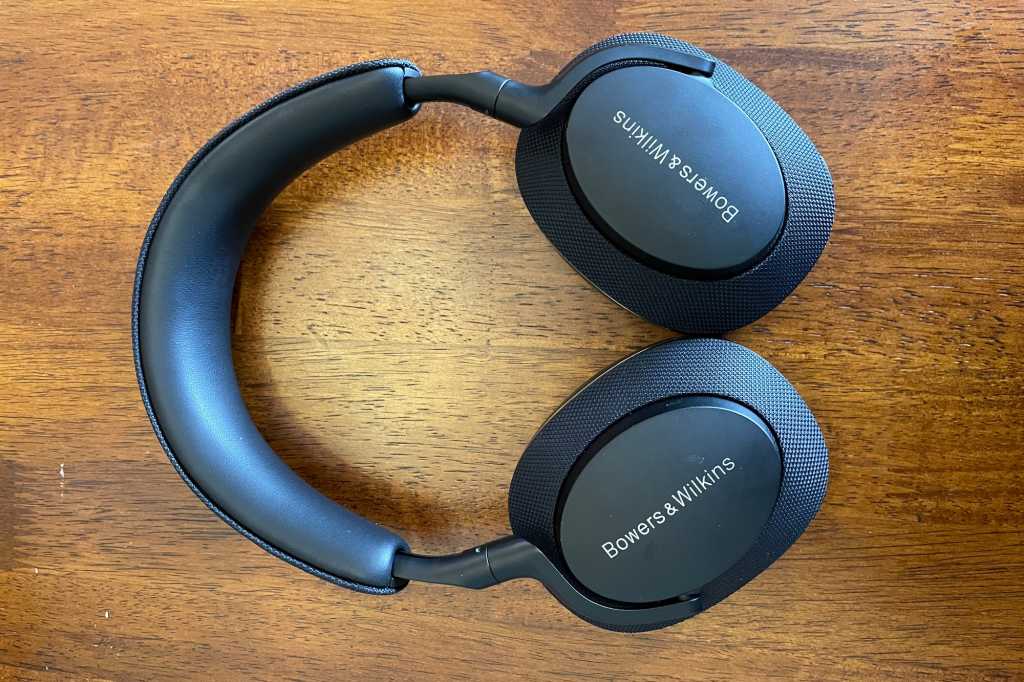Expert’s Rating
Pros
- Exceptional audio performance
- aptX Adaptive for hi-res audio streaming
- Very good active noise cancellation
- Excellent build quality
Cons
- B&W trails Sony in terms of whizbang features
- No support for surround sound formats, including Dolby Atmos
- Slightly bulkier than the Sony WH-1000XM5 they compete with
Our Verdict
The Bowers & Wilkins Px7 S2 are for ANC headphone shoppers who a) put audio fidelity at the top of their must-have list and b) are willing to forgo some of the flashy features the competition has to offer.
Price When Reviewed
$399.00
Best Prices Today: Bowers & Wilkins Px7 S2 noise-cancelling headphones

Not Available
Bowers & Wilkins has priced its Px7 S2 noise-cancelling headphones at $399; as such, the British audio giant is aiming squarely at the Japanese audio giant Sony. The Px7 S2 sound marvelous and deliver highly effective active noise cancellation, but Sony’s WH-1000XM5 offer a plethora of high-tech features you won’t find in B&W’s cans.
That’s not to say the Px7 S2 aren’t sophisticated. They have several great technical features, which I’ll delve into later. But for now, let’s focus on the headphones’ audio performance and the components that contribute to it. Bowers & Wilkins installed 40mm cellulose drivers in the Px7 S2. There’s a Bluetooth 5.0 radio onboard, with support for aptX Adaptive (to support hi-res streaming) as well as the AAC and SBC codecs. Sony supports its own LDAC Bluetooth codec for hi-res audio on the WH-1000XM5, but not any of the aptX codecs. B&W for its part, doesn’t support LDAC here.
This review is part of TechHive’s coverage of the best noise-cancelling headphones, where you’ll find reviews of the competition’s offerings, plus a buyer’s guide to the features you should consider when shopping for this type of product.
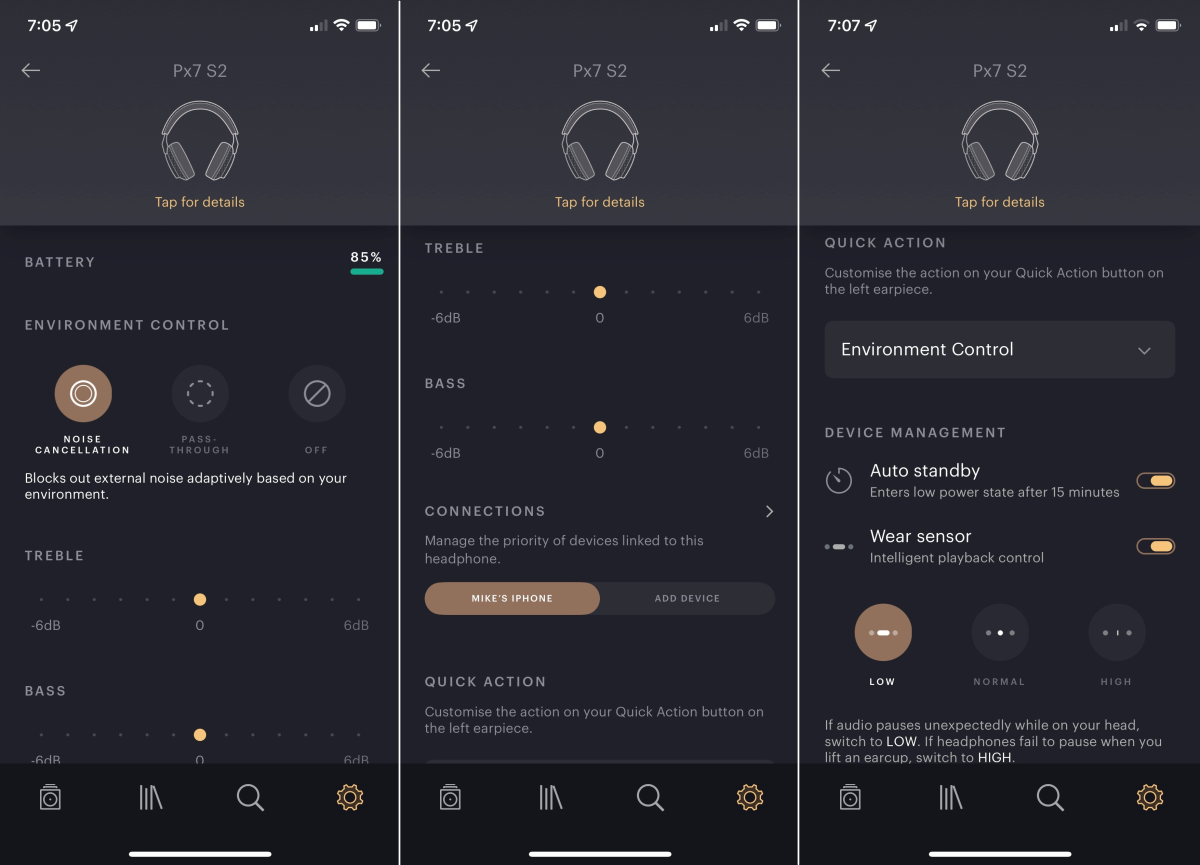
All of these functions are available on the same page of the B&W Music app, but you’ll need to scroll to see them all. The app shows the headphones’ remaining battery life, allows you to tweak its EQ profile (we left it flat while testing), program the custom button on the left-hand ear cup, and adjust a couple of other settings.
Michael Brown/Foundry
The latest Bowers & Wilkins Music app
I evaluated the Px7 S2 with an iPhone 12, streaming CD-quality and hi-res tracks from Qobuz (don’t miss our in-depth Qobuz review). The B&W Music app now supports headphone connections, but only for configuration purposes. You can’t stream music from the app to B&W’s headphones, only to its wireless speakers. B&W says support for streaming to headphones via the app will happen later this year.
So, what can you do with the app? You can turn active noise cancellation on or off, enable a pass-through mode that admits some ambient noise through to enhance your situational awareness, and make very minor EQ adjustments (as in boosting or cutting bass and treble levels by 6dB in either direction). You can also change the function of the single Quick Action button the left-hand ear cup, with your choices being toggling “environmental control,” i.e., the three levels of active noise cancellation (on, pass-through, or off), or activating your phone’s digital assistant (Siri or Google Assistant). There is no digital assistant support independent of your phone, so there is no onboard support for Alexa.
You can also toggle an auto standby feature that puts the headphones into a low-power state after 15 minutes, and you can activate a wear sensor that pauses music playback when you lift either ear cup; playback resumes when you put the cup back over your ear. The latter feature has three stages of sensitivity if you find that the headphones are pausing unexpectedly while they’re on your head.
Do the B&W Px7 S2 sound like $400 headphones?
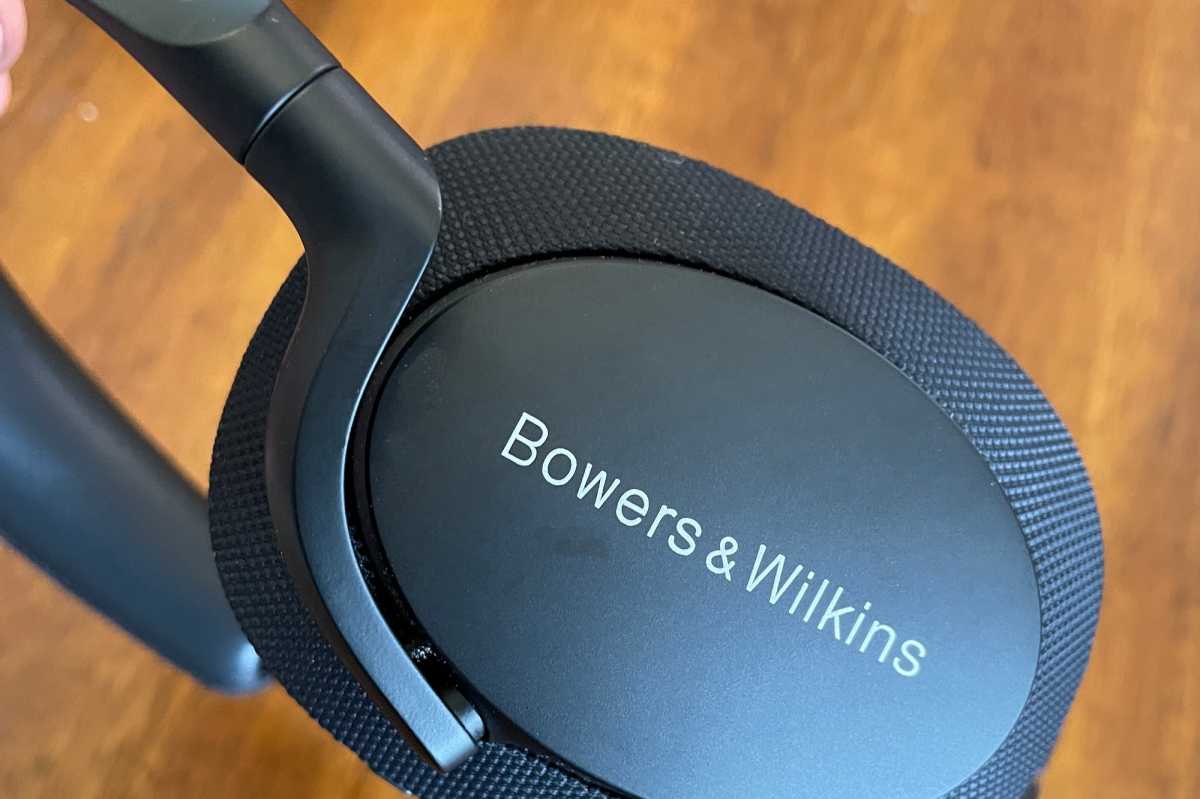
Despite their all-plastic construction, the B&W Px7 S2 feature robust build quality, including at the pivot points on the headband and ear cups..
Michael Brown/Foundry
Bowers & Wilkins fulfills its promise to deliver what it calls True Sound with the Px7 S2. These headphones deliver the sonic fidelity that audiophiles demand, even with active noise cancellation engaged. I could perceive no difference in audio reproduction with ANC on, passthrough mode engaged, or ANC off. To evaluate the headphones’ jazz chops, I listened to the 1962 Bill Evans, Shelly Manne collaboration Empathy, which was remastered to 24-bit, 96kHz in 2014. Playing “With a Song in My Heart,” the Px7 S2 rendered Evans’ piano and Monty Budwig’s bass with spectacular clarity, but Manne’s delicate work with his brushes on the snare and ride cymbal stand out even more.
I queued up Bruce Cockburn’s “Postcards from Cambodia” next. The Px7 S2 presented the track from Cockburn’s 2003 album You’ve Never Seen Everything streamed in CD quality on a sumptuously wide sound stage, yet you can easily pick out and focus on each instrument—guitar, marimba, bass, percussion—without losing track of the harmonic whole. Much of Cockburn’s vocals take the form of a spoken word poem, and you won’t miss a single phrase. And when Emmy Lou Harris joins him to sing harmony on the chorus, her angelic vocals take the song to a new level.
Playing a few Tower of Power tracks, including the raucous “Don’t Change Horses (in the Middle of the Stream)” from the band’s 1974 album Back to Oakland demonstrated the headphones’ ability to accurately reproduce intricate horn arrangements. This funk track has trumpets, saxes, trombones; the frenetic drum work of the great David Garibaldi, and Lenny Williams singing lead vocals. It sounded spectacular on the Px7 S2.

The B&W Px7 S2 have a lot of buttons. From right to left of the USB-C charging port: Volume down, pause/play, volume up, and a combo button for power and Bluetooth pairing.
Michael Brown/Foundry
How well do the B&W Px7 S2 handle noise cancelling and phone calls?
There was a time when I considered active noise cancellation anathema. How can any headphone cancel the whir of an air conditioner or the rumble of a jet engine without also cancelling out musical passages occupying the same frequency ranges? The best minds in the industry have cracked that code, and you no longer need to worry about it—at least not at this level. Bowers & Wilkins is newer to this game than Bose or Sony, but the Px7 S2 deliver excellent noise cancellation with virtually zero impact on music reproduction.
These headphones use four microphones—two that measure the output of each drive unit and two that monitor and react to outside noise—for hybrid active noise cancellation. Two additional mics are used for phone calls. A pass-through mode brings some sound from the outside world for a degree of situational awareness. As mentioned earlier, pass-through mode can be activated from within the B&W Music app, or you can program the Custom button on the left-hand ear cup to toggle the function on and off.
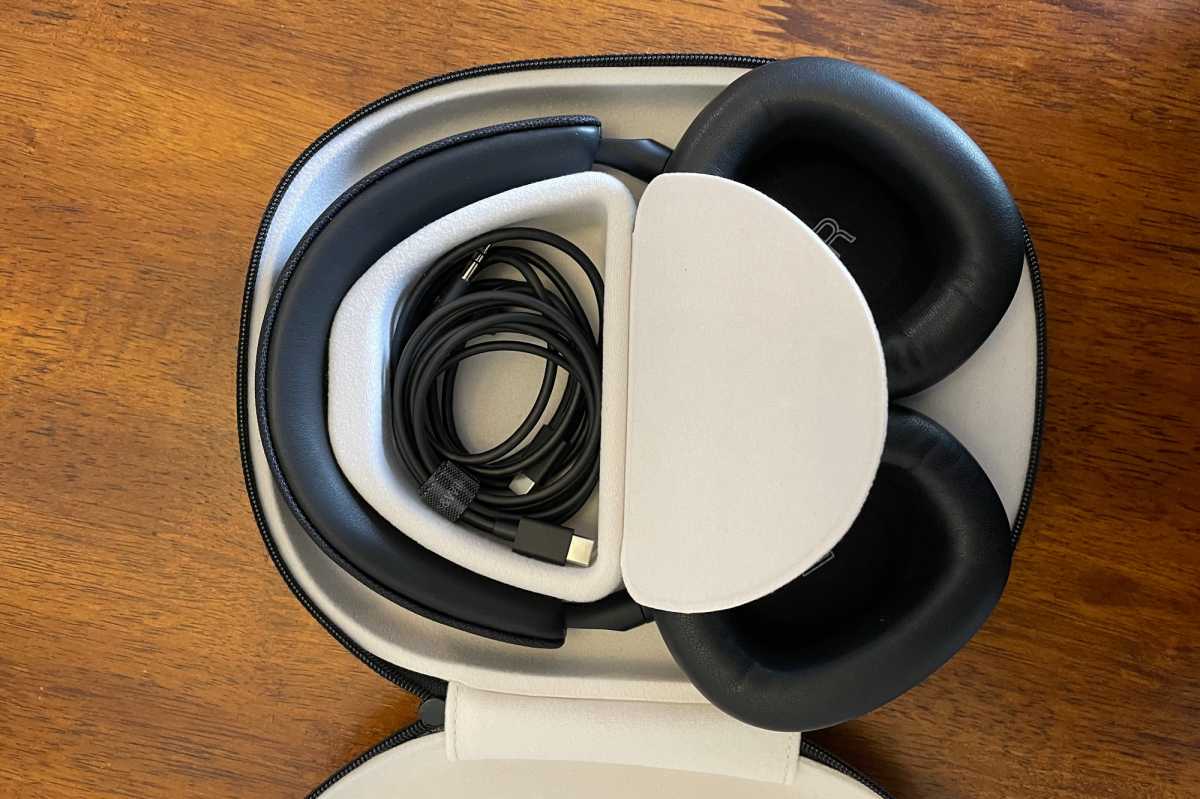
The B&W Px7 S2’s hardshell traveling case has a compartment for storing your cables. A USB-C charging cable is included, along with a USB-C-to-3.5mm audio cable.
Michael Brown/Foundry
I relocated to Portland, OR last fall and was surprised by a heat wave while I had the headphones in for review. Most Portland homes—mine included—don’t have air conditioning, so I set up a personal-sized evaporative cooler next to my desk and cranked it up to its highest setting. I measured an average of 50dB of noise at ear level an arm’s length from the cooler. I wasn’t able to measure decibel levels inside the headphones, of course, but with noise cancellation activated, I heard almost nothing at all—just a soft shush of white noise. I also played some simulated aircraft cabin noise over a powered bookshelf speaker system and the Px7 S2 eliminated nearly all of that noise, too.
I made a number of phone calls while wearing the Px7 S2, and the people one the other end of the line consistently sounded natural and said the same of me, even when I was outdoors in breezy conditions.
B&W Px7 S2 build quality and controls
Plastic construction was once an indicator of inferior build quality, but that’s certainly not the case here. Bowers & Wilkins selected that material for its light weight, its lower cost is a merely benefit. That said, the Px7 S2 do weigh two ounces more than Sony’s WH-1000XM5.
B&W wrapped the Px7 S2’s headband and earcups in a textile material on the outside, with memory-foam cushions on the surfaces that touch your body. The headband holds the ear cups tight to your head to deliver a considerable degree of passive noise isolation, but I wore the headphones for many hours-long listening sessions over the past week and never experienced fatigue—physically or sonically. And despite the faux leather ear cups—and that punishing heat wave—my ears never got sweaty.

Memory foam padding on the ear cups and headband, as shown here, make the B&W Px7 S2 comfortable for long listening sessions.
Michael Brown/Foundry
Where Sony has been using touch controls on its best ANC headphones, B&W opted for the surety of physical buttons. It’s a less sophisticated approach to be sure, and I never failed to inadvertently press one of the buttons (volume up, play/pause, or volume down) on the right-hand ear cup whenever I picked up the headphones or took them off my head. A fourth button located above those three slides up or down for power and to activate Bluetooth pairing. The button on the left-hand ear cup is mounted lower, so I wasn’t as apt to squeeze it inadvertently.
B&W also has no answer for Sony’s Speak-to-Chat feature, which automatically pauses your music when you begin speaking to someone and pipes their voice into the headphone, so you can carry on a conversation without needing to take the headphones off. The Px7 S2 will automatically pause the music when you lift the ear cup off either ear, and will resume playing when you lower it back. But if you’re doing anything more than answering a quick question, you’ll probably want to take the headphones off. That will still pause your music, and it’s the more polite thing to do anyway, but it’s not as sophisticated as Sony’s approach.
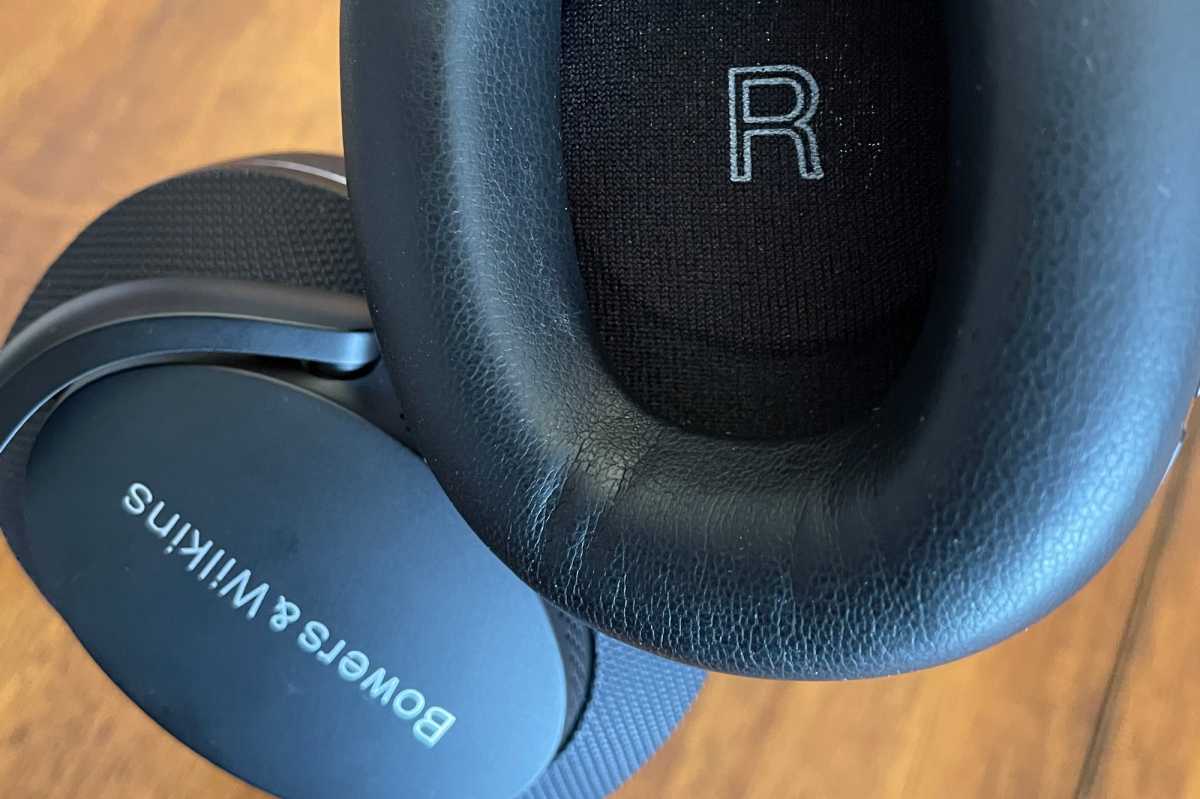
I appreciated the prominent right/left labels printed on the inside of the B&W Px7 S2’s ear cups. This important designation is all too often printed in small letters the same color of the ear cups, where it’s difficult to see.
Michael Brown/Foundry
Battery life, charging times, and traveling with the B&W Px7 S2
The Px7 S2 uses a lithium polymer battery, and Bowers & Wilkins says you can expect 30 hours of listening between full charges. A full charge requires about two hours, but a 15-minute quick charge will yield a generous seven hours of playing time. You won’t be surprised to hear the headphones have a USB-C charging port, or that B&W provides a USB-C-to-USB-C cable for this purpose. You’ll also find a USB-C to 3.5mm cable in the box that lets you connect the headphones to analog music sources. One item the company doesn’t supply is an adapter for plugging the headphone into an airplane armrest.
Many people buy noise-cancelling headphones for traveling, and the Px7 S2 fold relatively flat to fit into an attractive, cloth-wrapped, hard-shell case. The case is lined with a micro-fiber fabric, and a compartment with a magnetic catch provides a place to store your cables. You should also be able to fit a small AC adapter in that compartment, although B&W doesn’t provide one. I didn’t have a pair of Sony’s latest ANC headphones for comparison, but I do have the previous-generation WH-1000XM4 and they fold into an even more compact package.
The bottom line on B&W Px7 S2
Bowers & Wilkins’ Px7 S2 justify their $399 asking price with excellent musical performances and very good active noise cancellation. The folks at B&W clearly place a higher value on the former than the latter, and that’s a notion I can get behind with enthusiasm. Then again, I’m not a frequent air traveler. If you’re looking for best-in-class active noise cancellation and whiz-bang features like touch controls, surround sound, an even more sophisticated app, you should check out the Sony WH-1000XM5 before you pull the trigger on these cans. Take into consideration, however, that the Sony’s don’t support any of the aptX codecs (they do support Sony’s own LDAC tech).

